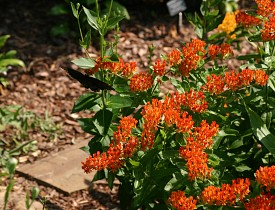Butterfly-Friendly Landscaping
 There is something magical about butterflies as they flit from flower to flower in the garden. These winged beauties are not only stunning to watch but they also serve an important role as pollinators, spreading pollen from flower to flower, leading to fertilization and ultimately seed production. The activities of butterflies and other pollinators, like hummingbirds and bees, help to ensure that various plant species multiply and persist.
There is something magical about butterflies as they flit from flower to flower in the garden. These winged beauties are not only stunning to watch but they also serve an important role as pollinators, spreading pollen from flower to flower, leading to fertilization and ultimately seed production. The activities of butterflies and other pollinators, like hummingbirds and bees, help to ensure that various plant species multiply and persist.
By growing certain combinations of plants and providing the right setting, you can attract butterflies and other welcome pollinators to your garden. Here are some tips for attracting butterflies.
1. Certain butterflies will only lay their eggs on specific plants. Find out what types of butterflies are in your area. This can be done through observation or by utilizing field guides.
2. You will need to plant both host and nectar plants. Host plants provide larval food for caterpillars and a place for them to lay their eggs. Once the caterpillars become butterflies, nectar plants are an important food source. If you grow herbs for cooking, plant a few extra for the butterflies.
3. Situate your butterfly garden in a location that receives 4-6 hours of direct sun.
4. Provide a source of shallow water (puddles are great), warm flat rocks for butterflies to sun on and some protection from strong winds. Shrubs are a good way to provide the necessary shelter.
5. Avoid using chemical pesticides which kill both bad and good bugs, including caterpillars.
6. Select a range of plants so that you will have blooms from spring until fall. This will maximize the opportunity to attract butterflies.
Below is a partial list of both host and nectar plants to attract and feed butterflies. Be sure to check with your local native plant society to find out the best natives for attracting butterflies.
Herbs
Fennel – Both the green and bronze are hosts for Black Swallowtails.
Parsley – A host for Black Swallowtails.
Basil – Provides nectar.
Dill – Is both a host plant and a source of nectar.
Annuals
Cosmos – A nectar source for the Painted Lady.
Hollyhock – A nectar source for the American Painted Lady.
Pansies – A nectar source for the Yellow Sulfur.
Salvia species – A host plant for many different butterflies.
Sunflowers – A larval source for the Painted Lady.
Verbena species – A nectar source for the Checkered Skipper.
Zinnia species – A nectar source for the Western Tiger Swallowtail.
Perennials
Asclepias species – Butterfly weed is both a host plant and a source of nectar for Monarchs.
Aster species – A nectar source for Black Swallowtails.
Echinacea species and cultivars – Coneflower is a nectar source for the Common Wood Nymph.
Eupatorium purpureum – Joepye weed is a nectar source for Giant Swallowtails.
Shrubs and Trees
Asimina triloba – Pawpaw is a host for the Zebra Swallowtail.
Buddleia davidii – The butterfly bush is a nectar source for the Black Swallowtail and Monarchs.
Fraxinus pennsylvanica – The green ash is a larval source for two types of Swallowtails.
Lindera benzoin – The spicebush is a host for Spicebush Swallowtails.
Populus tremuloides – Quaking aspen is a host for Mourning Cloaks.
Prunus serotina – Black cherry is a host for the Tiger Swallowtail.
Salix species – Willow is a host for the Red Spotted Purple.
Prunus virginiana – Chokecherry is a host for the Western Tiger Swallowtail.
Erica Glasener is a Hometalk - http://www.hometalk.com - writer. Read more articles like this one - https://www.networx.com/article/butterfly-friendly-landscaping - or get help with you home project on Hometalk.com.
Related Articles
Looking for a Pro? Call us (866) 441-6648

Landscaping Average Costs
Landscapers Experiences

Yard Clean Up Left Our Lawn Looking Fantastic

I Built A Concrete Retaining Wall As A Defense Against El Nino



